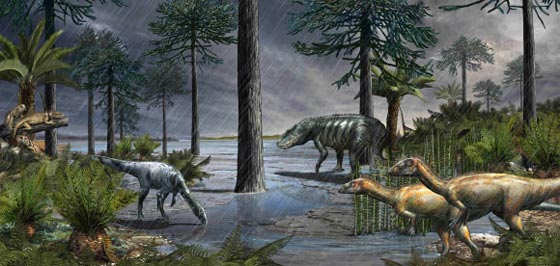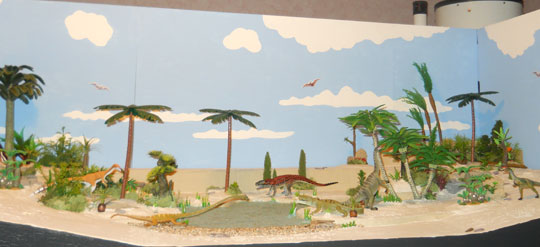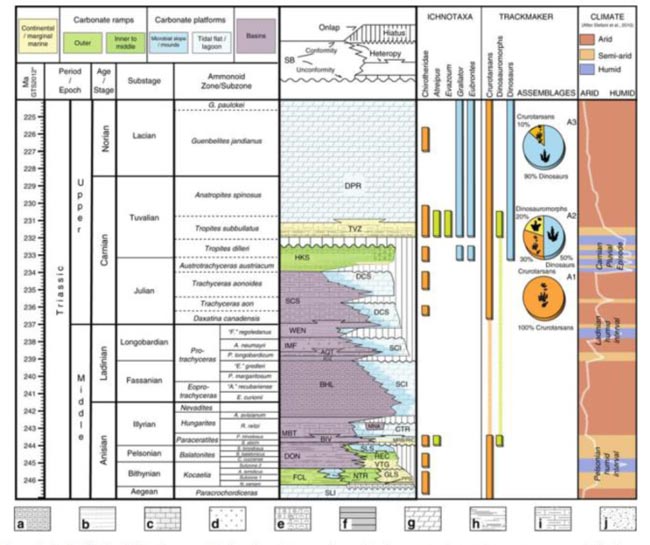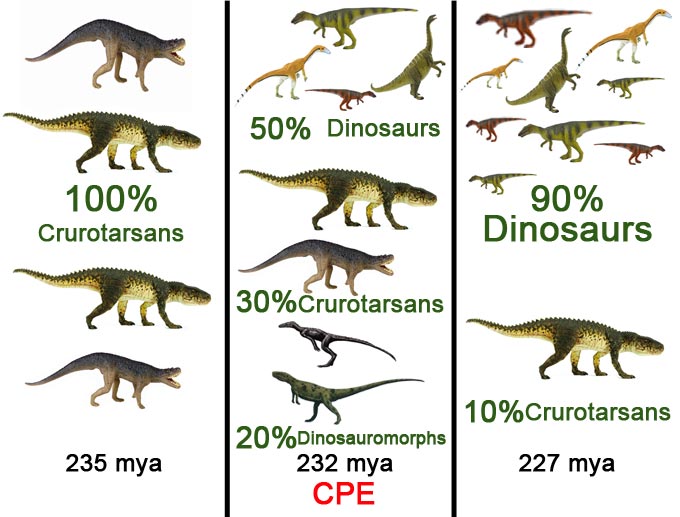Mass Extinction Event Paved the Way for the Dinosaurs
Dinosaur evolution where did it all start and why?
It is now widely accepted that dramatic, global climate change played a significant role in the extinction of the non-avian dinosaurs some 66 million years ago. The demise of the Dinosauria is well documented, but just how did this particular branch of the Archosauria rise to prominence and just as importantly, when did they start to dominate life on land?
There remains much to be learned about the origins of the dinosaurs, in addition, after the first dinosaurs evolved, for some 20 million years or so they made up only a tiny portion of terrestrial fauna, other reptiles dominated, then all of a sudden, at least when you consider the scale of geological time, the fossil record shows a change in the dinosaur’s fortunes. From being bit-part players in the Middle Triassic, by the Late Triassic they had taken centre stage.
Mass Extinction
Research published in the journal “Nature Communications”, postulates that the first, rapid diversification of the dinosaurs occurred following a dramatic global ecosystem crisis. This crisis was caused by rapid climate change, the ensuring mass extinction event cleared away a lot of competitors, especially herbivores. A mass extinction event resulted in the demise of the dinosaurs, but it seems likely (according to this new research), that a mass extinction event led to their ascendancy in the first place.
Terrestrial Life Around 234-232 Million Years Ago

Picture credit: Davide Bonadonna
The picture (above), shows a scene in the early Late Triassic of southern Pangaea around 232 million years ago. On the far left a pair of rhynchosaurs (diapsid, herbivorous reptiles characterised by stocky bodies, a squat gait and powerful beaks for cropping plants), lounge on a fallen tree. In the centre background a large, carnivorous rauisuchian is patrolling. Rauisuchians were archosaurs, but on the other branch of the Archosauria – the Crurotarsi which comprise crocodile-like animals, as opposed to the second main branch of the archosaurs the Avemetatarsalia, which houses the birds and the dinosaurs. The rauisuchian walks with an erect posture, (legs directly under the body). In the foreground, two species of light-weight, bipedal early dinosaurs are depicted.
The Carnian Pluvial Episode (CPE)
The study conducted by Massimo Bernardi of the MUSE (Museo delle Scienze of Trento) and Piero Gianolla of the University of Ferrara (Italy) in collaboration with Professor Michael Benton of Bristol University, provides evidence to suggest that the diversification of the Dinosauria followed the Carnian Pluvial Episode, a time when the Earth went from an extremely arid climate to a humid and substantially wetter climate, before reverting back to arid once again. This dramatic period in Earth’s history occurred between 234 and 232 million years ago (during the Carnian faunal stage of the Late Triassic).
The cause of this violent swing in our planet’s weather patterns is elusive, but most palaeontologists consider the huge volcanic eruptions in western Canada and the outpouring of vast quantities of igneous material, which are represented today by the great Wrangellia basalts as the engine for climate change. What is termed Large Igneous Province (LIP) volcanism, resulted in huge amounts of carbon dioxide being released into the atmosphere. This led to rapid, ocean acidification, increased rainfall and dramatic global warming turning a dry world dominated by large deserts in central Pangaea, into much more humid and wetter environments.
For Much of the Triassic the Land was Dominated by Deserts

Picture credit: R. Townsend
Everything Dinosaur stocks a wide range of models of Triassic terrestrial animals including rauisuchians and early dinosaurs. For example, we recommend the CollectA range of not-to-scale models and replicas: CollectA Prehistoric Life Models and Figures.
Dating Ichnoassemblages from the Dolomites (Southern Alps)
The researchers examined the ancient Triassic fauna of South America and compared these palaeoenvironments with data from the Italian Dolomites. Although dinosaur and other reptile fossils from Triassic sediments are relatively widespread, for example Triassic vertebrate fossils are known from North America, South Africa, China, Europe and England, accurately dating these deposits has proved to be extremely difficult. Hence the significance of the Italian Dolomites.
The stratigraphy of the Southern Alps and of the Dolomites in particular covers virtually the whole of the Middle and Late Triassic. The sequence of strata, can be dated using a variety of methods, which when cross-referenced provides one of the most detailed geological timescales of the early Mesozoic anywhere on Earth.
Dating the Dolomites – A Bio-Chrono-Stratigraphic Framework

Picture credit: Nature Communications/Bernardi, Gianolla, et al
Preserved in the Rocks
Preserved in the rocks of the Dolomites are a series of tracks and trackways. These footprints provide palaeontologists with an idea of the animals around at the time the sequence of strata was being laid down. This research team noticed that prior to the Carnian Pluvial Episode, when this part of the world was arid, the tracks were dominated by Crurotarsi archosaurs, in the early Carnian 100% of the tracks represent these crocodile-like reptiles.
However, during the Carnian Pluvial Episode (CPE), 50% of the tracks represent dinosaurs, whilst just 20% indicate the presence of Crurotarsi archosaurs, the rest are associated with dinosauromorphs, close relatives of the true dinosaurs. As the world entered the Norian faunal stage of the Late Triassic, some 227 million years ago, nearly all the tracks preserved in this region (90% plus) were made by dinosaurs.
Diversification of the Dinosaurs
The complicated chart above, plots the occurrence of several precisely dated ichnoassemblages in the Late Triassic of the Southern Alps allowing the research team to date, relatively precisely, the timing of the diversification of the dinosaurs in this part of Pangaea. On the left of the chart is the timeline in millions of years, the Period/Epoch and the faunal stage and sub-stage are noted. Helping to relatively date the sequence of rocks are the zonal fossils, in this case ammonites, the rocks of this region can be mapped sequentially using key fossil ammonite species which provide a biostratigraphical reference.
The sequence of geological formations are shown and the various ichnotaxa associated with them are displayed. The scientists identify the probable track maker and describe them as dinosaurs (sky blue), dinosauromorphs (light green) or crurotarsans (orange). The length of the coloured column shows the time interval over which the tracks have been found.
Absence of Dinosaur Tracks
Note the absence of dinosaur tracks in the Middle Triassic (bottom part of the chart), however, blue columns (dinosaur tracks) dominate the top part of the chart, the Late Triassic. Pie charts show percentage breakdown of the different tracks, pre, during and post the CPE. The final column on the far right provides details of the palaeoenvironment and the flipping from arid to humid and then back again.
Geological Formations Abbreviations: ADZ: Zoppè Sandstone; AQT: Acquatona Formation; BHL: Livinallongo/Buchenstein Formation; BIV: Bivera Formation; CTR: Contrin Formation; DCS: Cassian Dolomite; DON: Dont Formation; DPR: Dolomia Principale; FCL: Coll’Alto dark Limestones; GLS: Gracilis Formation; HKS: Heiligkreuz Formation; IMF: Fernazza Formation and volcanites; MBT: Ambata Formation; MNA: Moena Formation; MRB/RIC: Richthofen Conglomerate and Morbiac dark Limestone; NTR: Monte Rite Formation; PPS: Piz da Peres Conglomerate; REC: Recoaro Limestone; SCI: Sciliar Formation; SCS: San Cassiano Formation; SLI: Lower Serla Dolomite; SLS Upper Serla Formation; TVZ: Travenanzes Formation; VTG: Voltago Conglomerate; WEN: Wengen Formation.
The small boxes underneath the chart provide a key to the general characteristics of the rocks associated with each geological formation: (a) cherty limestone; (b) sandstone; (c) sandy limestone; (d) volcanics; (e) oolitic-bioclastic limestone; (f) black platy limestone or dolostone, black shale; (g) dolostone; (h) marlstone, claystone and shale; (i) marly limestone; (j) conglomerate.
Summarising the Study – Pointing Towards a Mass Extinction
In summary the lithology (characteristics of the rocks), the length of the sequence of deposition, helping to provide absolute dating information along with the abundance of zonal fossils to permit relative dating, allow scientists to accurately map the geological time represented by the strata. This precise dating has enabled the researchers to tease out the significance of the CPE in reference to the evolution of the dinosaurs.
The Diversification of the Dinosaurs Coincides with the Carnian Pluvial Episode

Picture credit: Everything Dinosaur
Over a period of around 8 million years the palaeofauna of the southern Alps as shown by trace fossils changed dramatically. Dinosaur trace fossils become much more abundant. The researchers conclude that the dinosaurs diversified explosively in the middle Carnian, at a time of major climate and floral change and the extinction of key herbivores, which the dinosaurs opportunistically replaced. The trace fossils found in the Dolomites region therefore play a crucial role in understanding the evolution of the Dinosauria.
Commenting on the significance of the study, one of the authors, Dr Piero Gianolla (University of Ferrara) stated:
“We had detected evidence for the climate change in the Dolomites. There were four pulses of warming and climate perturbation, all within a million years or so. This must have led to repeated extinctions.”
A Link Between Dinosaur Evolution and the CPE
The discovery of the existence of a link between the first diversification of the dinosaurs and the CPE is unexpected and revolutionary. This dramatic event not only paved the way for the dinosaurs to dominate terrestrial ecosystems, but also permitted the diversification of many other types of tetrapod, including lizards, crocodiles, turtles and mammals, key terrestrial animals in today’s ecosystems. The scientists conclude that they have developed a new framework for the evolution of the most famous reptiles.
The scientific paper: “Dinosaur diversification linked with the Carnian Pluvial Episode” by Massimo Bernardi, Piero Gianolla, Fabio Massimo Petti, Paolo Mietto and Michael J. Benton published in the journal “Nature Communications”.
For dinosaur and prehistoric animal models including Triassic animals: Dinosaur and Prehistoric Animal Models.






Leave A Comment